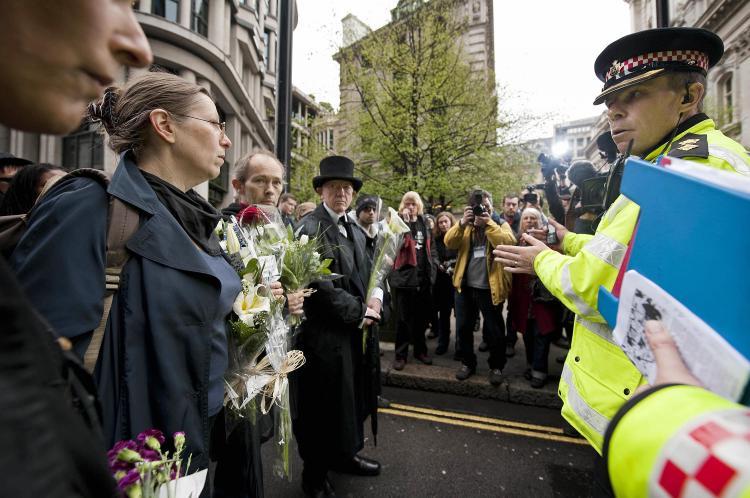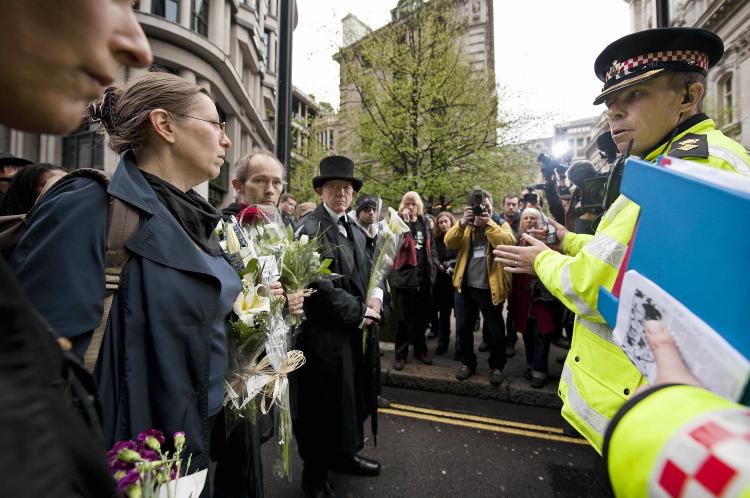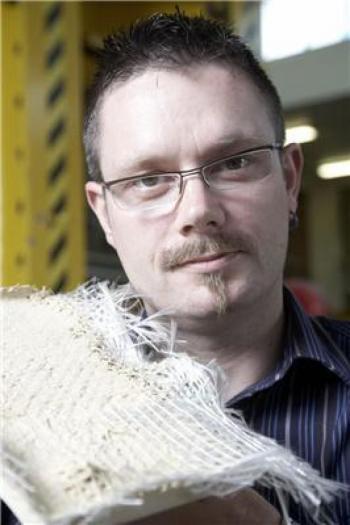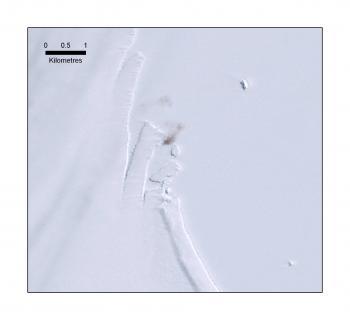A London police officer may face manslaughter charges over the assault of G20 casualty, Ian Tomlinson, after a second post-mortem shifted the cause of death from heart attack to internal abdominal bleeding.
Mr. Tomlinson, a newspaper vendor, died shortly after being assaulted by a policeman.
He was trying to walk home through crowds of protesters and police cordons on April 1, near the Bank of England. The 47-year old was hit and thrown to the ground while walking away from the police as seen in video footage from The Guardian.
The first post mortem by Home Office pathologist Dr Freddy Patel concluded that Tomlinson died of a heart attack. His findings after two days were based on several injuries, a substantial amount of blood in the abdominal cavity and a heavily diseased heart and liver. Senior officers were led to believe that Mr. Tomlinson was a heavy drinker who died of a heart attack.
Dr. Nathaniel Cary, an independent forensic pathologist, carried out the second post mortem after both the Independent Police Complaints Commission (IPCC) and solicitors acting for Mr. Tomlinson’s family initiated a criminal inquiry after viewing the amateur footage.
Paul King, Mr. Tomlinson’s stepson, said after the second post mortem, “We believe we were badly misled by police about the possible role they played in Ian’s death. First we were told that there had been no contact with the police, then we were told that he died of a heart attack. Now we know that he was violently assaulted by a police officer and died from internal bleeding. As time goes on we hope that the full truth about how Ian died will be made known.”
The City of London coroners court released the following statement: “Dr. Cary’s opinion is that the cause of death was abdominal hemorrhage. The cause of the hemorrhage remains to be ascertained. Dr. Cary accepts that there is evidence of coronary atherosclerosis but states that in his opinion its nature and extent is unlikely to have contributed to the cause of death.”
“The opinions of both consultant pathologists are provisional and both agree that their final opinions must await the outcome of further investigations and tests. These are likely to take some time.
“The IPCC’s investigation into the death of Ian Tomlinson is ongoing.”
An IPCC spokesman said, “Following the initial results of the second post mortem, a Metropolitan Police Officer has been interviewed under caution for the offence of manslaughter as part of an on-going inquiry into the death of Ian Tomlinson.”
The officer responsible for striking Mr. Tomlinson to the ground has been suspended and placed on sick leave after suffering from a panic attack after the results of the second post mortem and the footage was released.
A gray area that now exists is whether the assault by the police officer contributed to the internal bleeding that killed Ian Tomlinson. It is not common for someone to die from bleeding caused by falling, yet if the fall caused internal bleeding, his heavily-diseased liver may have been unable to provide stable blood clotting, resulting in death.
Jules Carey, Mr. Tomlinson’s family attorney said, “The video footage of the unprovoked and vicious assault on Ian by the police officer would easily justify charges of assault being brought against the officer. The findings of Dr. Nat Carey significantly increase the likelihood that the officer will now face the more serious charge of manslaughter.”
The maximum penalty for which, would be life imprisonment.
Meanwhile, Sir Paul Stephenson, Metropolitan Police Commissioner, amidst increasing concerns of police brutality has ordered a review of public order policing after the way the City of London police and his force handled the G20 protests.
Another unclear issue is why the first post mortem was referred to Dr. Patel, instead of an independent pathologist. Dr. Patel had previously been disciplined by the General Medical Council after releasing medical details regarding the controversial death of a man in police custody. He was also questioned in another suspicious death case, when police stopped investigating the cause of a woman’s death after he gave his opinion that she died of natural causes. The man who lived with the dead woman continued to murder and mutilate two more women.
On the other hand, Dr. Carey has a proven track record of discerning suspicious death cases, including proving that cricket coach Bob Woolmer’s death was not suspicious and proving that serial killer Harold Shipman’s victims did not die of natural causes.
Regarding the case, Boris Johnson, the Mayor of London and chairman of the Metropolitan Police Authority, said, “There must now be a fast and transparent conclusion to the IPCC investigation”
“The Met receives and deserves the overwhelming support of the people of London, but the family of Ian Tomlinson need answers.”
Mr. Tomlinson, a newspaper vendor, died shortly after being assaulted by a policeman.
He was trying to walk home through crowds of protesters and police cordons on April 1, near the Bank of England. The 47-year old was hit and thrown to the ground while walking away from the police as seen in video footage from The Guardian.
The first post mortem by Home Office pathologist Dr Freddy Patel concluded that Tomlinson died of a heart attack. His findings after two days were based on several injuries, a substantial amount of blood in the abdominal cavity and a heavily diseased heart and liver. Senior officers were led to believe that Mr. Tomlinson was a heavy drinker who died of a heart attack.
Dr. Nathaniel Cary, an independent forensic pathologist, carried out the second post mortem after both the Independent Police Complaints Commission (IPCC) and solicitors acting for Mr. Tomlinson’s family initiated a criminal inquiry after viewing the amateur footage.
Paul King, Mr. Tomlinson’s stepson, said after the second post mortem, “We believe we were badly misled by police about the possible role they played in Ian’s death. First we were told that there had been no contact with the police, then we were told that he died of a heart attack. Now we know that he was violently assaulted by a police officer and died from internal bleeding. As time goes on we hope that the full truth about how Ian died will be made known.”
The City of London coroners court released the following statement: “Dr. Cary’s opinion is that the cause of death was abdominal hemorrhage. The cause of the hemorrhage remains to be ascertained. Dr. Cary accepts that there is evidence of coronary atherosclerosis but states that in his opinion its nature and extent is unlikely to have contributed to the cause of death.”
“The opinions of both consultant pathologists are provisional and both agree that their final opinions must await the outcome of further investigations and tests. These are likely to take some time.
“The IPCC’s investigation into the death of Ian Tomlinson is ongoing.”
An IPCC spokesman said, “Following the initial results of the second post mortem, a Metropolitan Police Officer has been interviewed under caution for the offence of manslaughter as part of an on-going inquiry into the death of Ian Tomlinson.”
The officer responsible for striking Mr. Tomlinson to the ground has been suspended and placed on sick leave after suffering from a panic attack after the results of the second post mortem and the footage was released.
A gray area that now exists is whether the assault by the police officer contributed to the internal bleeding that killed Ian Tomlinson. It is not common for someone to die from bleeding caused by falling, yet if the fall caused internal bleeding, his heavily-diseased liver may have been unable to provide stable blood clotting, resulting in death.
Jules Carey, Mr. Tomlinson’s family attorney said, “The video footage of the unprovoked and vicious assault on Ian by the police officer would easily justify charges of assault being brought against the officer. The findings of Dr. Nat Carey significantly increase the likelihood that the officer will now face the more serious charge of manslaughter.”
The maximum penalty for which, would be life imprisonment.
Meanwhile, Sir Paul Stephenson, Metropolitan Police Commissioner, amidst increasing concerns of police brutality has ordered a review of public order policing after the way the City of London police and his force handled the G20 protests.
Another unclear issue is why the first post mortem was referred to Dr. Patel, instead of an independent pathologist. Dr. Patel had previously been disciplined by the General Medical Council after releasing medical details regarding the controversial death of a man in police custody. He was also questioned in another suspicious death case, when police stopped investigating the cause of a woman’s death after he gave his opinion that she died of natural causes. The man who lived with the dead woman continued to murder and mutilate two more women.
On the other hand, Dr. Carey has a proven track record of discerning suspicious death cases, including proving that cricket coach Bob Woolmer’s death was not suspicious and proving that serial killer Harold Shipman’s victims did not die of natural causes.
Regarding the case, Boris Johnson, the Mayor of London and chairman of the Metropolitan Police Authority, said, “There must now be a fast and transparent conclusion to the IPCC investigation”
“The Met receives and deserves the overwhelming support of the people of London, but the family of Ian Tomlinson need answers.”





